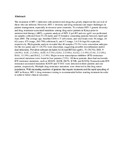| dc.description.abstract | The treatment of HIV-1 infection with antiretroviral drugs has greatly improved the survival of those who are infected. However, HIV-1 diversity and drug resistance are major challenges in patient management, especially in resource-poor countries. To evaluate HIV-1 genetic diversity and drug resistance-associated mutations among drug-naive patients in Kenya prior to antiretroviral therapy (ART), a genetic analysis of HIV-1 pol-RT and env-gp41 was performed on samples collected from 53 (18 males and 35 females) consenting patients between April and June 2005. The average age, baseline CD4(+) T cell counts, and viral loads were 38 (range, 24-62) years, 475 (range, 203-799) cells/mm(3), and 4.7 (range, 3.4-5.9) log(10) copies/ml, respectively. Phylogenetic analysis revealed that 40 samples (75.5%) were concordant subtypes for the two genes and 13 (24.5%) were discordant, suggesting possible recombination and/or dual infections. Prevalent subtypes included A1/A1(pol-RT/env-gp41), 31 (58.5%); D/D, 9 (16.9%); A1/C, 2 (3.8%); A1/D, 4 (7.5%); G/A1, 2 (3.8%); A1/A2, 1 (1.9%); C/A1, 2 (3.8%); D/A1, 1(1.9%); and D/A2, 1 (1.9%). Major reverse transcriptase inhibitor (RTI) resistance-associated mutations were found in four patients (7.5%). Of these patients, three had nucleoside RTI resistance mutations, such as M184V, K65R, D67N, K70R, and K219Q. Nonnucleoside RTI resistance-associated mutations K103N and Y181C were detected in three patients and one patient, respectively. Multiple drug resistance mutations were observed in this drug-naive population. With increasing numbers of patients that require treatment and the rapid upscaling of ART in Kenya, HIV-1 drug resistance testing is recommended before starting treatment in order to achieve better clinical outcomes. | en |

